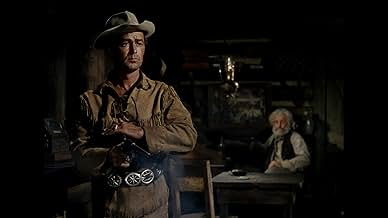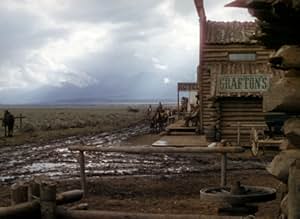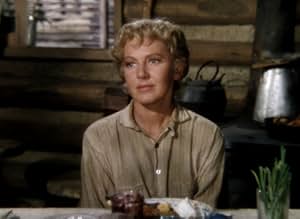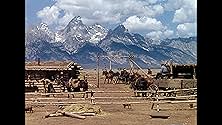Un cansado pistolero intenta establecerse con una familia, pero un conflicto latente entre colonos y ganaderos lo obliga a actuar.Un cansado pistolero intenta establecerse con una familia, pero un conflicto latente entre colonos y ganaderos lo obliga a actuar.Un cansado pistolero intenta establecerse con una familia, pero un conflicto latente entre colonos y ganaderos lo obliga a actuar.
- Dirección
- Guionistas
- Elenco
- Ganó 1 premio Óscar
- 8 premios ganados y 13 nominaciones en total
- Jack Wilson
- (as Walter Jack Palance)
- Dirección
- Guionistas
- Todo el elenco y el equipo
- Producción, taquilla y más en IMDbPro
Opiniones destacadas
Shane was directed by George Stevens who admittedly directs with a strictness that borders on fascism. And yet he pulls it off with aplomb. Ladd's character is criticized as well, because he is played by Ladd himself, an actor that is an easy target for certain critics. There's the old joke about Ladd standing in a hole (outside of camera view) to match the heights of his leading ladies, or by standing on a ramp or box so their heights in close-ups would be matched for love scenes. Is this the 'stuff' of western heroes? Not hardly. So here we have "little Alan" taking on one of the most vicious actors that ever played 'Satan Incarnate', the incomparable Jack Palance! Jack's 'Lucifer' is a messenger from hell hired by the bad'uns to save them all from Ladd's goodness. Jack wakes up shortly after arriving in town to assassinate another little man, Elisha Cook Jr., in a scene which was completely and shamelessly ripped off by Eastwood in 'Pale Rider'. The death is completely believable and establishes Palance's character as unstoppable.
The characters in Shane are cut from a woodcarving, they glisten with familiar yet surprising motivations. Ben Johnson, the Sainted actor of westerns plays a very small part that almost steals the film. The bad guys in this film are a textbook rendition of meaness.
But some say that the action is subdued in Shane. But I say the build-up is worth the wait as the final climatic shoot-out has been described by many western film scholars as the best that was ever put to film.
Shane a waste of film? I think not.
I first saw "Shane" from the back seat of a '51 Ford, at a drive-in theater somewhere in Montana. The movie was new, and I was about 4 years old. From that time, I remember quiet male voices and the ring of spurs. Those sounds have lived in my mind for decades.
"Shane" is a classic -- no, not a bang-bang shoot-em-up B Western, but it is a solid Western that gives fans of the genre some something to think about besides "they went thataway." The scenery (Jackson Hole, Wyoming) is grand and was even moreso on the big screen. When well known Western novelist A.B. Guthrie wrote the screenplay, he kept fairly faithful to Jack Schaefer's novel. The movie makes a reasonable attempt, for that time, to look authentic in costume and gear, and gives fans of the movies of the '40s and '50s some interesting cinematic moments (see the small things, like how the camera was used to make Alan Ladd seem more "heroic").
I'd probably recast some of the secondary roles, if I had the chance, but Ladd's soft-spoken, gentlemanly way is just right for Shane, and Jack Palance is subtly evil.
Yes, "Shane" contains a few clichés, but they weren't yet quite so cliché, in 1953. Besides, they were well done clichés, so, while you may recognize them, you probably won't mind them.
But, what's "Shane" about, exactly?...
Courage. Loyalty. Honor. Friendship.
It will leave you wishing you knew what happened next.
There are so many scenes in SHANE that standout as epic. They are like the jagged mountainscapes that dominate the picture: A young boy, slogging around in a marsh, aims his toy gun on a deer grazing on some grass stems, the deer lifts it's antlers and perfectly frames a lone rider approaching in the distance, a struggling family homestead held together by hard work, the father splitting wood, the mother baking in the kitchen, and always the mountains jutting upwards away off in the distance.
We have a stranger, lean and handsome, dressed in fringed buckskin. His dress and gun belt suggest something other than a farmer or rancher, yet we never really know, or ever know, of his past. He is kind and modest, and takes time to address the boy as though someone worth talking to, "You were watching me down the trail quite a spell, weren't you. I like a man who watches things going around.....He can make his mark someday." the boy smiles up at him, and an instant bond is formed, an idol worship in the making.
We have snickering, troublesome ranchhands who spend any free hours swilling whiskey at Graftons General Merchantile. "I thought I smelled pig. Which one of those tatter-pickers are you working for? Or are you just squattin' on the range?" this is the kind of menace that dogsany farmer who dares to come into town.
We have Shane, although trying to lead the simple life of farming, goaded into a fight by a sweaty-faced cowpoke (Ben Johnson). His bloodying of the cowpoke is like a violent ballet, graceful and cutting.
There is a meeting of the homesteaders, huddled together by lamplight, trying to solve there problems by resolving to go into town all together so that they would have strength in numbers. This is a rather sad scene since WE know that will be in vain.
There is touching elegance to the 4th of July celebration where there is fiddle music and dancing. Shane and Marion (the boy's mother) take a few turns to a reel..... dancing with others in the corral. Van Heflin (the Boy's father) is symbolically shut out beyond the fence. "Marion, they fenced me out" he grins. Yet we know that there is a growing affection between the two dancers.
There is tension in the late evening when the head of the ranchers pays visit to the homestead. "Look Starrett. When I come to this country you weren't much older than your boy there........ How would you like to go partners with me." It's sad because this is a real if clumsy attempt to "be reasonable" But as Shane would say on more than one occasion, "it's no use".
I could go on; the murder of the Stonewall at the hands of an especially evil hired gun from Cheyenne has great impact. And, the final confrontation at Graftons one fateful night, is one of the best in Westerns.
The characters are well developed and the story, while exiting, is a little melancholy.
The best Western ever made.
¿Sabías que…?
- TriviaPrincipal photography had been completed in October, 1951, but the amount of coverage shot by George Stevens resulted in such an extremely protracted editing process that the film wasn't released until August, 1953. All this drove up the costs of what should have been a simple, straightforward Western; in fact, they spiraled so much that Paramount approached Howard Hughes about taking on the property, but he declined. He changed his mind when he saw a rough cut and offered to buy the film on the spot. This made Paramount rethink its strategy--originally it was going to release it as a "B" picture but then decided it should be one of the studio's flagship films of the year. This proved to be a good decision, as the film was a major success and easily recouped its inflated budget.
- ErroresAt the beginning, when Shane rides a horse down the hill, Teton Pass Highway is visible in the background.
- Citas
Shane: I gotta be going on.
Joey: Why, Shane?
Shane: A man has to be what he is, Joey. Can't break the mould. I tried it and it didn't work for me.
Joey: We want you, Shane.
Shane: Joey, there's no living with... with a killing. There's no going back from one. Right or wrong, it's a brand. A brand sticks. There's no going back. Now you run on home to your mother, and tell her... tell her everything's all right. And there aren't any more guns in the valley.
Joey: Shane...
[Joey notices that Shane is wounded]
Joey: It's bloody! You're hurt!
Shane: [Shane starts to stroke Joey's hair] I'm all right, Joey. You go home to your mother and father and grow up to be strong and straight. And, Joey... take care of them, both of them.
Joey: Yes, Shane.
[Shane rides off]
- Créditos curiososIntroducing Brandon De Wilde
- Versiones alternativasThe film was shot in Academy Ratio (1.33:1 or 4:3), but this was done around the time widescreen filmmaking was coming around. As such, many theatres cropped the film into a widescreen ratio to take advantage of this, with many DVDs being cropped as well. The 2013 Blu-ray Disc release is in the proper Academy Ratio.
- ConexionesEdited into Go West, Young Man! (2003)
- Bandas sonorasAbide With Me
(uncredited)
Music by William H. Monk (1861)
Hymn by Henry F. Lyte (1847)
Played on piano and sung by many at a meeting
Also played and sung at a funeral
Selecciones populares
Detalles
Taquilla
- Presupuesto
- USD 3,100,000 (estimado)
- Total a nivel mundial
- USD 21,412
- Tiempo de ejecución
- 1h 58min(118 min)
- Color
- Relación de aspecto
- 1.37 : 1(original aspect ratio)




































